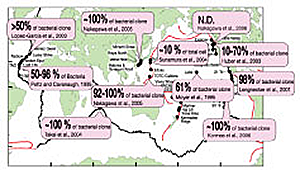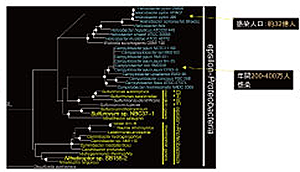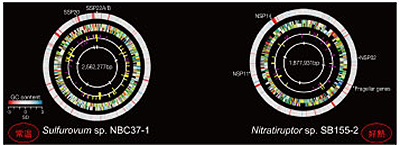Achievements
[2003年-2007年]
The most dreaded pathogensf ancestor, gthe previously unknownh deep-sea Epsilon proteobacteria, were cultivated and characterized comprehensively, and their genomes were determined for the first time in the world
Since the late 1990s, it has been gradually revealed that the global deep-sea hydrothermal environment is overwhelmingly dominated by a specific group of microorganisms, Epsilonproteobacteria. The closest isolated strains of deep-sea Epsilonproteobacteria were the Campylobacter and the Helicobacter pylori, which cause stomach cancer and diarrhea, and they were not known much for their mysterious predominance and their relationship with the relative pathogens. Here, in SUGAR Project at JAMSTEC, we decided to tackle this mystery by encouraging two of our good-looking research scientists (Satoshi Nakagawa, finally got married in 2010, and Ken Takai, already taken) to engage in this puzzle-solving! Not only good-looking, but these two scientists were surely smart enough to solve this mystery; they gracefully took the lead in isolating deep-sea Epsilonproteobacteria in advance to the worldfs researches in this area, and proved these unknown bacteria were of the chemolithoautotrophic microorganisms, which generate energy from molecular hydrogen and sulfur compounds in the hydrothermal fluids. Moreover, they carried out genome analyses, and found out that these deep-sea bacteria possess genetic characteristics and molecular biological mechanisms in order to win in their competitions to dominate in the deep-sea hydrothermal environments. Now, thanks to their analyses, it can be said that these are the inherited harmful ancestral characteristics from the ancient world...!

Dominance of Epsilonproteobacteria in the global deep-sea hydrothermal systems.

Phylogenetic tree to show Epsilonproteobacteria (marked in yellow) being a close relative to Helicobacter pylori and Campylobacter.

Two genome sequences of Epsilonproteobacteria decoded by SUGAR Project at JAMSTEC. One is of mesophilic Epsilonprobacterium, and another is of thermophilic Epsilonbacterium. The mesophilic Epsilonproteobacterium is quite a close relative strain to the ones that live symbiotically inside of Alviniconchafs gills. The genome analyses of symbiotic Epsilonproteobacteria are currently on the process, and in the near future, the comparison of free-living and symbiotic Epsilonproteobacteria will be possible in genomic level.
